- Sail Loot Podcast 063: Sailing With FIRE on Luna Sea with Mark and Jennifer
- Sail Loot Podcast 062: Andersons Abroad own Sea-Tech Systems to make Sailing Money
- Sail Loot Podcast 048: Neil Davies Sails to Cuba and Works Remotely for Sailing Money
- Sail Loot Podcast 042: Wiley Sharp, Part 2 – Owning and Operating a Virgin Islands Sailing Charter
- Sail Loot Podcast 037: Salty Times Sailing to find the Surf with Base and Jamie
- Sail Loot Podcast 027: Couchsailors Jose and Gina Rent All of their Rooms for Sailing Money
- Sail Loot Podcast 020: Leah Kruger Makes Her Sailing Money With Brio
- Sail Loot Podcast 019: Good Anchorage, Get Paid To Cruise
- Sail Loot Podcast 013: Investing Money to Make Money While Sailing the Mediterranean with Franz Amussen
- Sail Loot Podcast 012: From Corporate America to Ottsworld with Sherry Ott
Basic Cruising Course: The Second Step to Improving Sailing Skills – Day Two
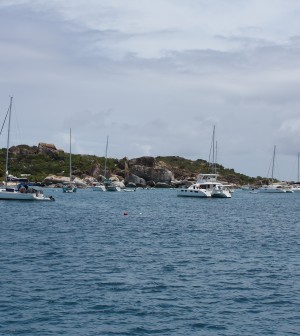
I started day two waking up right around 6 AM. Rory had told us that we had to get up and start heading over to the wreck of the Rhone at about 7 AM. I was obviously a little excited!
Cindy was going to be the captain for that day, but our sailing class hadn’t really started yet. We were getting up early to head from Cooper Island down around the Southwest side of Salt Island and hook up to a mooring ball at Rhone National Park. Therefore, Rory allowed me to get us off our mooring ball in Manchioneel Bay and motor over to the Rhone National Park.
It was pretty easy to get up early that morning. I’m normally a late sleeper, but when the sun comes up and you’re excited about what you’re going to be doing that morning, it’s really easy to go ahead and pop out of bed.
Fred had started the coffee in the percolator, and it was time to start the engines and get on over to the Rhone. Some storms did come through the night before. They weren’t bad storms but it had rained most of the night. It was still very overcast in the morning, and on our way to Salt Island we were noticing that there was a little bit of chop in the seas.
We thought that this wouldn’t be any big deal. After all, at 60 feet under the sea there isn’t much red color from the sunlight anymore and things are mostly blue. However, as we popped out from the leeward side of Salt Island we noticed that the chop was getting a lot heavier.
There was some current, but hopefully it was only some surface current. Hopefully, once we got down a few feet into the water, we wouldn’t have to swim too hard into the current to get to the Rhone.
Once we hooked up our mooring ball, Megan, Rory, and I got all of our scuba gear set up. I don’t think Fred liked how much the boat was rocking while we were getting things set up, but he was a champ! He let us know that he didn’t like it, but he would put up with it while we went on a dive because he knew that that’s what we really wanted to do.
We tied up a line to the port transom of the boat and decided to jump in. Our plan was to swim on the surface to the bow of our boat, Allison. We would start our dive from there and have to keep going that direction in order to get to the wreck.
It was a tough swim to the bow of the boat, but everybody made it without any issues. We looked around at each other and made sure everybody was okay. We made sure that everybody was ready and gave the thumbs down signal to descend.
As we were descending everybody seemed to be doing alright. We were just making sure we could regulate while descending to the sandy bottom at 40ft deep.
When I was about 5 feet from the bottom I looked at Rory and he was flashing hand signals to me. He pointed up. He gave me the boat signal. When I found the boat above us I realized that we were twenty feet behind the stern of the boat. The current pushed us from the bow of the boat to 20 feet behind the stern of the boat even though we trying to swim forward while descending.
We had to abort the dive. There was no way that we were going to get to the wreck of the Rhone with any air left in this current. I shrugged, kind of looking at Rory and saying, “what are you going to do,” and gave him the thumbs up sign to ascend back to the boat.
I then turned around and found Megan. I gave her all of the signals to explain what was going on. We all ascended to Allison’s stern. Let me tell you, that was no easy swim.
Unfortunately, we did not get to dive the Rhone that morning. All that means is that we’ll have to come back! In the end, this trip was all about learning to sail. All of the dives and other adventures were just an added bonus!
We climbed aboard Allison with all of our gear and started rinsing everything off. We could tell that Fred wasn’t feeling so hot at this point. It was time to get off this mooring ball as quickly as we could and set sail.
Cindy was our captain for the day so she went up to the helm and started the engines. Rory had tasked Megan and Fred with releasing the lines and storing them, and I helped out wherever I could.
Once we got off the mooring ball Cindy turned the boat North to get back around to the leeward side of Salt Island. The rest of us got back up to the cockpit and took our positions so that we could man all of the lines. Cindy pointed the boat into the wind, we made sure all of the reefing lines could run free, we got the main halyard around a winch, and we raised the main sail.
Allison’s jib was on a rolling Furler. There is no need to be head to wind when unrolling the jib. So, we got on course to our next destination… The Baths!
As soon as we were on course it was time to unroll the jib. We were on a starboard tack. Therefore, we made sure that the starboard jib sheet was free to run and that port jib sheet was around a winch. We had one person pulling the port jib sheet and one person holding light tension on the furling line to make sure that we didn’t get an override on the drum.
Once all sails were out we turned off the engines and we were sailing.
We spent the rest of the morning beating up to the Southwestern tip of Virgin Gorda. We hadn’t done a whole lot of sailing the afternoon before so we spent some time performing tacks and nailing down all of the steps that each crew member had to take to perform each maneuver.
We went over the timing involved in the maneuvers and how each crew member plays a role. How fast Allison’s bow is turned through the wind, when to release the jib sheet and when to sheet the other, controlling the main sail, and how Allison responded were all critical steps in performing our maneuvers for the morning.
Megan was really excited to be heading to The Baths for lunch. We all were really, but it wasn’t listed on our itinerary for our sailing class. She was talking about going on an island trail run if we anchored up at Bitter End Yacht Club on the Northeast side of Virgin Gorda. She didn’t have to do that though, and she was excited that Rory was planning on picking up a mooring ball in Spring Bay for lunch.
Cindy was at the helm as I used the boat hook to pick up the mooring ball and Megan and Fred helped with the lines. It was still fairly early in the afternoon so we decided to explore The Baths before eating lunch.
We took the dinghy over to the tether line and swam the rest of the way to shore. We hiked through the natural tidal pools, tunnels, arches, and scenic grottoes from Spring Bay around to Devil’s Bay. When we were done with our trek, Rory, Megan, and I snorkeled around the water side of the granite boulders to our dinghy. We practiced seal like maneuvers to hop in, and drove back around to Devil’s Bay to pick up Fred and Cindy. The Baths were an amazing site to see.
We drove the dinghy back to Allison, ate some lunch, and dropped our mooring ball so that we could set sail. Our final destination for the day was an anchorage in North Sound on the Northeast side of Virgin Gorda.
We sailed North from Spring Bay and hugged the leeward side of Virgin Gorda for the rest of the afternoon. Rory was our tactician for the sail. He would point out the wind shifts and ask us about how the topography changes were affecting the wind. He told us when to tack and explained all of his reasoning along the way.
The rest of us were the crew. We were pulling lines and going over all of the steps for each maneuver line by line. We were always asking questions along the way and we each had a turn at each sheet, line, halyard, wheel, and winch.
When we were headed around the point of Long Bay on the Northwest side of Virgin Gorda it was time to race! Rory had pointed out a monohull ahead of us and said, “Lets catch them.” We were constantly trimming the sails to make sure that we were harnessing maximum wind power. Fred was at the helm and the rest of us were pulling lines. We were all reading the wind and calling out puffs and lulls when we saw them. We watched for other boats and practiced our rules for right of way.
We eventually caught the monohull we were chasing. We headed up around the point keeping Saddle Bay and Cow Bay to starboard. We overtook the monohull and completed our last leg of the sail up to the inlet of North Sound. We started the engines, furled the jib, dropped the main sail, and headed into the channel between Mosquito Island and Prickly Pear Island.
On our second night aboard Allison it was time to actually stay on the hook. This would be our first time anchoring so Rory explained all of the details of picking our anchorage, dropping the anchor, letting out scope at a 7:1 ratio, and making sure the anchor was set. He also went over the use of the windlass with us.
We picked our anchorage, drove over to it, and dropped the anchor right on top of where we wanted it to be. We then let out 7 feet of chain for every foot of water depth plus freeboard. When 105 feet of chain had been let out we attached the bridal and let out just enough more chain so that there was a loose loop between the bridal hook and the windlass. If Allison pulled on her anchor chain it would now be with the nylon rope of the bridal that was attached to the port and starboard bow. This would give a little bit of elasticity to the anchor rode and get all of the forces off of the windlass system.
Here are the steps we used to make sure that our anchor was set:
- Pick 2 stationary points abeam that were lined up and not on the boat.
- Put the throttles in reverse at 1000 RPM for 90 seconds and make sure that your stationary points are still lined up.
- If your stationary points are still lined up increase the reverse RPM of both engines to 2000 RPM for 90 seconds.
- If your stationary points are still lined up increase the reverse RPM of both engines to 2500 RPM for 120 seconds.
- If your stationary points are still lined up, then your anchor is probably dug in and set pretty well. Bring the engine throttle back to neutral and shut off the engines. Successful anchorage!
- If at any time in this process the points you picked seem to move, and their alignment changes, then you have 2 options. You can put out more scope and try again, or start all over by weighing anchor and picking a new anchorage.
Our anchor was set very well the first time! It was time for Megan and I to teach. One of the rules that we had learned sailing Kalalau was that every successful anchorage deserved rum drinks!
We started up the GenSet, got some AC going, plugged in the blender, and made some rum drinks. We drank our delicious drinks during a quick sailing “classroom” lesson in the galley. By the time we were done it was time to start thinking about dinner, but we had another instructor joining us for the next few days.
Tom was another instructor at Rob Swain Sailing School who had flown in from Pennsylvania to teach a monohull sailing class. When he arrived in the islands, he found out that his students had cancelled so he asked if we minded if he joined us. Our only stipulation was that he had to bring more beer!
Rory took the dinghy to get Tom and the rest of us started prepping for the steak, potato, and salad dinner that we cooked on board. It was Cindy’s turn to pick the tunes. The Doors were turned up, Rory returned with Tom, a fantastic dinner was grilled, and we ate, drank, and enjoyed the company of new friends until it was time to turn in.
Day 3 of our Basic Cruising Course was another great sail! Check back in a few days to read all about it!
Leave a comment below or check us out over on Facebook if you want to chat. We’d love to hear about your adventures!
TeddyJ


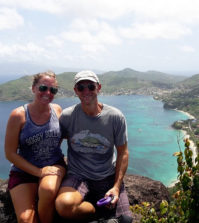
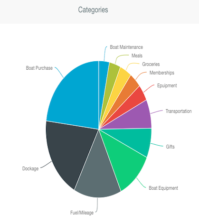
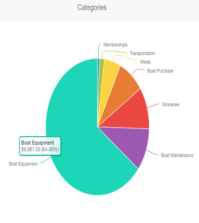
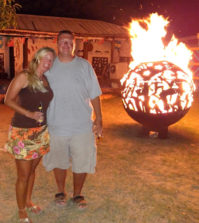
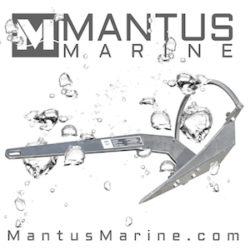

One Comment